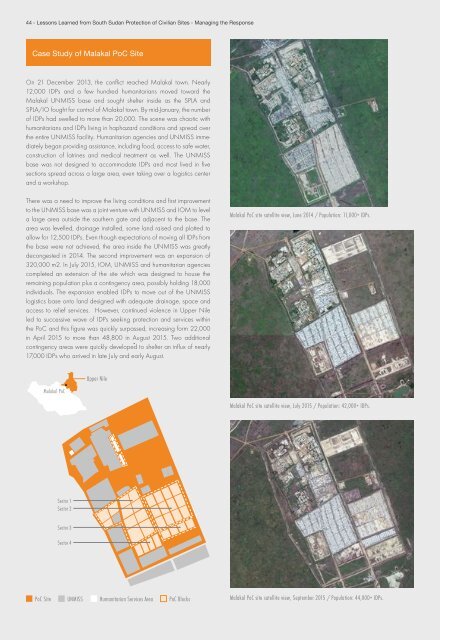Lessons Learned from South Sudan Protection of Civilian Sites 2013–2016
if_we_leave_0
if_we_leave_0
Create successful ePaper yourself
Turn your PDF publications into a flip-book with our unique Google optimized e-Paper software.
44 - <strong>Lessons</strong> <strong>Learned</strong> <strong>from</strong> <strong>South</strong> <strong>Sudan</strong> <strong>Protection</strong> <strong>of</strong> <strong>Civilian</strong> <strong>Sites</strong> - Managing the Response<br />
Case Study <strong>of</strong> Malakal PoC Site<br />
On 21 December 2013, the conflict reached Malakal town. Nearly<br />
12,000 IDPs and a few hundred humanitarians moved toward the<br />
Malakal UNMISS base and sought shelter inside as the SPLA and<br />
SPLA/IO fought for control <strong>of</strong> Malakal town. By mid-January, the number<br />
<strong>of</strong> IDPs had swelled to more than 20,000. The scene was chaotic with<br />
humanitarians and IDPs living in haphazard conditions and spread over<br />
the entire UNMISS facility. Humanitarian agencies and UNMISS immediately<br />
began providing assistance, including food, access to safe water,<br />
construction <strong>of</strong> latrines and medical treatment as well. The UNMISS<br />
base was not designed to accommodate IDPs and most lived in five<br />
sections spread across a large area, even taking over a logistics center<br />
and a workshop.<br />
There was a need to improve the living conditions and first improvement<br />
to the UNMISS base was a joint venture with UNMISS and IOM to level<br />
a large area outside the southern gate and adjacent to the base. The<br />
area was levelled, drainage installed, some land raised and plotted to<br />
allow for 12,500 IDPs. Even though expectations <strong>of</strong> moving all IDPs <strong>from</strong><br />
the base were not achieved, the area inside the UNMISS was greatly<br />
decongested in 2014. The second improvement was an expansion <strong>of</strong><br />
320,000 m2. In July 2015, IOM, UNMISS and humanitarian agencies<br />
completed an extension <strong>of</strong> the site which was designed to house the<br />
remaining population plus a contingency area, possibly holding 18,000<br />
individuals. The expansion enabled IDPs to move out <strong>of</strong> the UNMISS<br />
logistics base onto land designed with adequate drainage, space and<br />
access to relief services. However, continued violence in Upper Nile<br />
led to successive wave <strong>of</strong> IDPs seeking protection and services within<br />
the PoC and this figure was quickly surpassed, increasing form 22,000<br />
in April 2015 to more than 48,800 in August 2015. Two additional<br />
contingency areas were quickly developed to shelter an influx <strong>of</strong> nearly<br />
17,000 IDPs who arrived in late July and early August.<br />
Malakal PoC site satellite view, June 2014 / Population: 11,000+ IDPs.<br />
Upper Nile<br />
Malakal PoC<br />
Malakal PoC site satellite view, July 2015 / Population: 42,000+ IDPs.<br />
Sector 1<br />
Sector 2<br />
Sector 3<br />
Sector 4<br />
PoC Site<br />
UNMISS<br />
Humanitarian Services Area<br />
PoC Blocks<br />
Malakal PoC site satellite view, September 2015 / Population: 44,000+ IDPs.


